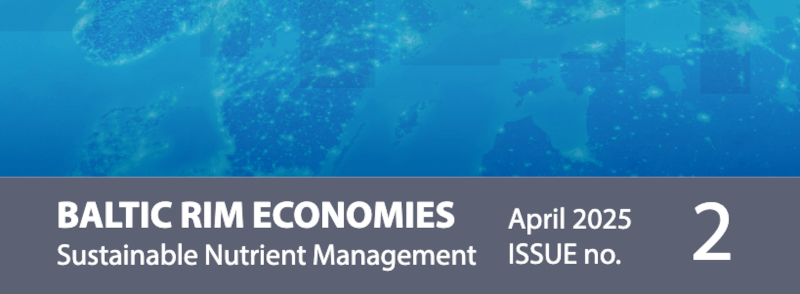
Once in decline due to persecution and pollution, cormorants have rebounded across the Baltic Sea since the 1980s thanks to legal protection, cleaner waters, and healthier fish stocks, now breeding widely along the coasts of Sweden, Denmark, Finland, Germany, Estonia, Latvia, and Poland.
In our recent contribution to Baltic Rim Economies (BRE, Issue #2, April 2025), Erik Sindhøj and I outlined current challenges and opportunities in implementing a circular economy for nutrients in the Baltic Sea Region (BSR). The article, part of a series curated by The Centrum Balticum Foundation, reflects ongoing efforts within the Interreg-funded CiNURGi project and the broader framework of the EU Strategy for the Baltic Sea Region (EUSBSR).
The Baltic Sea continues to suffer from nutrient overloads, primarily due to linear models of nutrient use in agriculture. While awareness of the issue is high, translating policy into practice remains complex. In CiNURGi, we work with public and private actors across sectors to co-develop regionally adapted solutions that support nutrient recycling, improve soil health, and reduce emissions to air and water.
Identifying the Systemic Bottlenecks
Through CiNURGi, we’ve identified several persistent bottlenecks:
- Economic viability of Recycled Nutrient Fertilizers (RNFs): RNFs still struggle to compete with synthetic mineral fertilizers, both in pricing and distribution.
- Spatial misalignment of biomass flows: Nutrient-rich areas (often livestock-intensive) are geographically distant from nutrient-deficient croplands.
- Trust and quality assurance: Ensuring agronomic consistency and contaminant safety remains a critical concern, especially among farmers and food producers.
To address these, CiNURGi is piloting nutrient recovery technologies and developing transparent safety and performance assessment protocols, which we believe are prerequisites for wider adoption.
From Pilot to Policy
Technological innovation alone will not drive change. What’s equally important is governance and policy alignment. At the EU level, existing frameworks such as the Fertilising Products Regulation (FPR) and the Common Agricultural Policy (CAP) provide partial levers, but more integrated strategies are needed.
One area of strategic importance is regional infrastructure planning. A circular economy for nutrients requires not just technology, but also logistics—transport, storage, and matching nutrient sources with end-use demand. CiNURGi contributes to this with nutrient flow mapping and by exploring collaborative models between municipalities, farmers, and industry.
Centre-Periphery Dynamics and Market Incentives
Another concern we explore is the persistent centre-periphery dynamic in nutrient redistribution. We call for greater attention to regional nutrient autonomy, which includes local market development and tailored incentives. These could take the form of public procurement guidelines, RNF certification schemes, or tax relief structures.
Market incentives must be designed with both scalability and environmental integrity in mind. The future of RNFs in the BSR will depend on building not just pipelines of material flow, but also pipelines of trust and accountability.
Supporting Structures for Change
The EU Strategy for the Baltic Sea Region, particularly through PA Nutri, plays a pivotal role in convening actors, sharing knowledge, and aligning national and regional efforts. Since 2022, The Centrum Balticum Foundation has hosted the Baltic Sea Strategy Point (BSP), which provides critical support for coordinating and communicating this work. I see this as a significant step toward better governance and implementation of circular solutions in the region.

On this Issue of Baltic Rim Economies
This issue of BRE is particularly rich in perspectives on sustainable nutrient management. In addition to the article co-authored with Erik Sindhøj, I contributed a second article titled “Closing the nutrient loop: Stakeholder insights from CiNURGi” (Expert Article 3816). This piece focuses on how CiNURGi engages with municipalities, utilities, and researchers to develop Testbed Ellinge in southern Sweden as a demonstration site for sludge pyrolysis, phosphorus recovery, and carbon-negative soil amendments.
Other highlights from the issue include:
- Perspectives on soil health and biogas digestate valorisation.
- Overviews of nutrient recovery technologies from wastewater treatment.
- Country-specific strategies from Denmark, Finland, and Sweden.
- Reflections on farmer perceptions and the trust dimension in adopting recycled nutrient products.
These contributions underscore the systemic and collaborative nature of building circularity into agriculture and wastewater systems in the BSR. The full issue is accessible via www.centrumbalticum.org/en, along with other publications like Pulloposti and the BSR Policy Briefing.